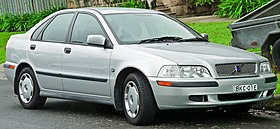Volvo S40
| Volvo S40 | |
|---|---|
 |
|
| Overview | |
| Manufacturer | Volvo Cars |
| Production | 1995–2012 X40: 1996–2004 (1st generation) P1: 2004–2012 (2nd generation) |
| Body and chassis | |
| Class | C-segment (compact car/small family car) |
| Layout | Front-engine, front-wheel-drive or four-wheel-drive |
| Chronology | |
| Predecessor | Volvo 440/460 |
| Successor | Volvo V40 II |
| First generation | |
|---|---|
 |
|
| Overview | |
| Production | 1995–2004 (1,000,034 units) |
| Model years | 1996–2004 |
| Assembly | Netherlands: Born (NedCar) Malaysia: Shah Alam (SMA) South Africa: Pretoria Thailand: Rayong |
| Designer | Peter Horbury |
| Body and chassis | |
| Body style | 4-door saloon (S40) 5-door estate (V40) |
| Layout | Front-engine, front-wheel-drive |
| Related |
Mitsubishi Carisma Proton Waja |
| Powertrain | |
| Engine | 1.6 L I4 (petrol) 1.8 L I4 (petrol) 1.9 L I4 (petrol) 1.9 L turbo I4 (diesel) 2.0 L I4 (petrol) 2.0 L turbo I4 (petrol) |
| Transmission | 5-speed Volvo M56 manual, 4-speed Aisin AW50-42LE automatic, 5-speed Aisin AW55-50 automatic |
| Dimensions | |
| Wheelbase | 2,550 mm (100.4 in) (2000–01) 2,557 mm (100.7 in) (2002–04) |
| Length | 4,470 mm (176.0 in) (2000–01) 4,521 mm (178.0 in) (2002–04) |
| Width | 1,720 mm (67.7 in) (2000–01) 1,717 mm (67.6 in) (2002–04) |
| Height | 1,410 mm (55.5 in) (2000–01) 1,423 mm (56.0 in) (2002–04, S40) 1,426 mm (56.1 in) (2002–04, V40) |
| Kerb weight | S40: 1,220–1,392 kg (2,690–3,069 lb) V40: 1,234–1,414 kg (2,721–3,117 lb) |
| Second generation | |
|---|---|
 |
|
| Overview | |
| Production | 2004–2012 |
| Model years | 2004–2012 |
| Assembly | Belgium: Ghent (VCG) China: Chongqing Malaysia: Shah Alam (SMA) South Africa: Pretoria |
| Body and chassis | |
| Body style | 4-door saloon |
| Layout | Front-engine, front-wheel-drive or four-wheel-drive |
| Platform | Volvo P1 platform |
| Related |
Volvo V50 Volvo C30 Volvo C70 II Mazda3 Ford Focus |
| Powertrain | |
| Engine | 1.6 L I4 (petrol) 2.0 L I4 (petrol/ethanol) 2.4 L I5 (petrol) 2.5 L turbo I5 (petrol) 1.6 L I4 (diesel) 2.0 L I4 (diesel) 2.0 L I5 (diesel) 2.4 L I5 (diesel) |
| Transmission | 5-speed Volvo M56 manual, 6-speed Volvo M66 manual, 5-speed Aisin AW55-50 automatic, 6-speed Aisin TF-80SC automatic |
| Dimensions | |
| Wheelbase | 2,640 mm (103.9 in) |
| Length | 2004–2005: 4,468 mm (175.9 in) 2006–2007: 4,475 mm (176.2 in) 2008–2012: 4,483 mm (176.5 in) |
| Width | 1,770 mm (69.7 in) |
| Height | 1,452 mm (57.2 in) (FWD) 1,470 mm (57.9 in) (AWD) |
| Curb weight | 1,435–1,505 kg (3,164–3,318 lb)(FWD) 1,552–1,579 kg (3,422–3,481 lb)(AWD) |
The Volvo S40 is a compact luxury car marketed and produced by the Swedish manufacturer Volvo Cars from 1995 to 2012 across two generations.
The first generation (1995–2004) was introduced in 1995 with the S40 (S from saloon) and V40 (V from versatility, estate) cars.
The second generation (2004–2012) was released in 2004, and the estate variant's name changed to V50.
The range was replaced by the Volvo V40 five-door hatchback in 2012.
During August 1995, Volvo released its new series, with the intention of calling the cars S4/F4. However, as Audi had already reserved the "S4" name, Volvo opted to name the range S40 (saloon), and V40 (estate). These cars were manufactured at the Nedcar factory in the Netherlands (a pre-Ford joint venture between Volvo and Mitsubishi Motors) and based on a common platform with the Mitsubishi Carisma and the Proton Waja. In the UK market it cost approximately 50% more than the related Mitsubishi Carisma. The car helped changed perceptions of Volvo: "The S40/V40 range was the car that finally persuaded buyers that Volvo really could build a credible compact executive car", reported the RAC.
The V40, with a drag coefficient of 0.32, was the first whole model to be introduced under the direction of the British designer Peter Horbury, Volvo’s design director, and was marketed in Australia, South America and the Far East. The V40 was named the ‘Most Beautiful Estate Car in the World’ at an Italian award ceremony. The official première was at the Frankfurt Motor Show, in September 1995, with the V40 premièring in December 1995, at the Bologna Motor Show.
In 2000, Volvo updated the 40 Series ("Phase II"), implementing a number of technical improvements, including improved engine management, diesel direct fuel injection, extra safety features, larger brake discs, new front suspension and steering, revised rear suspension, larger tyres and a wider track. A minor facelift gave larger headlights, more streamlining and larger rear light clusters as well as minor instruments and fascia re-design. The "Phase II" 40 series finally went on sale on the North American market for the model year 2000.
...
Wikipedia
